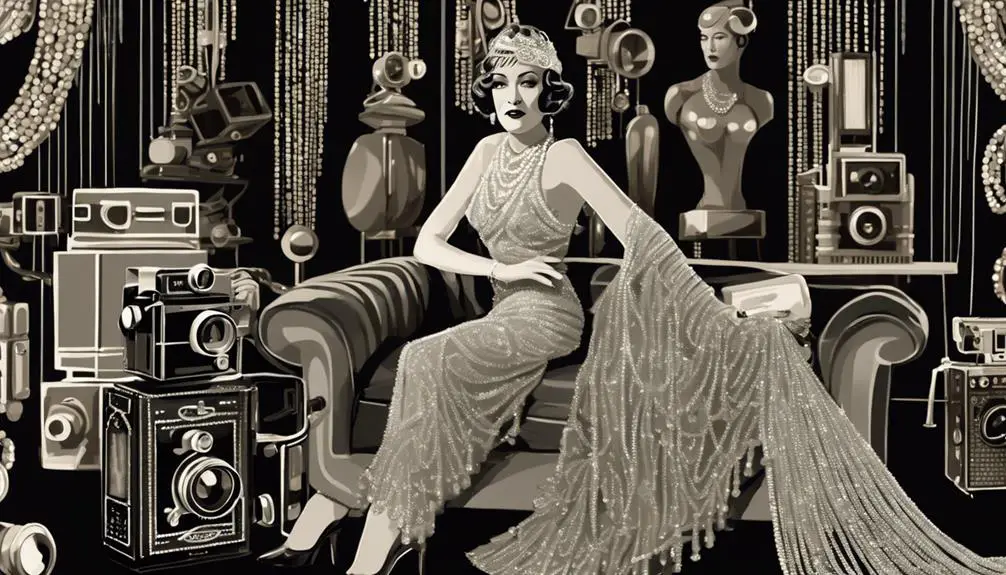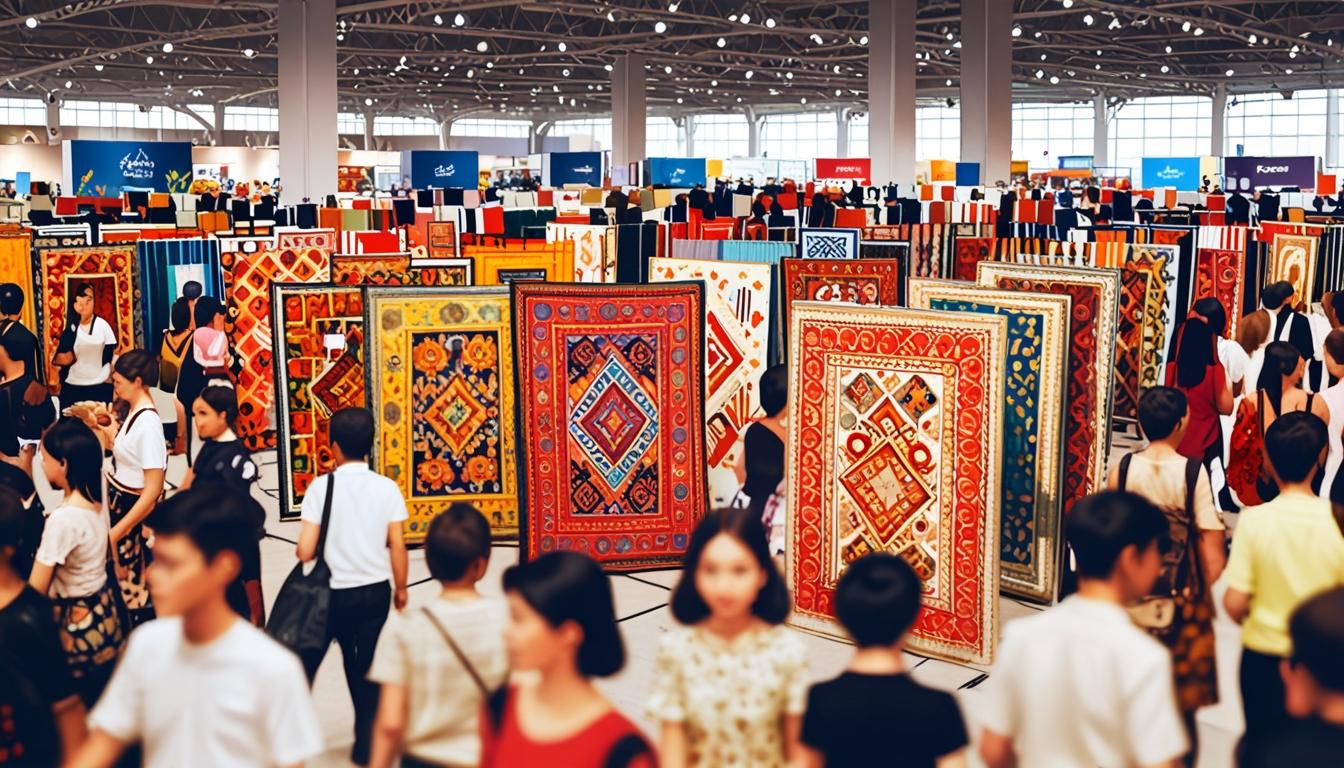Picture a glamorous Hollywood set, where pearls glisten under the soft lights and feathers swirl with every dramatic turn. You can't help but notice how Gloria Swanson's fashion choices not only adorned her but also told a story, shaping the characters she portrayed. Her collaborations with top designers created unforgettable looks that still resonate today. As we explore Swanson's most iconic moments, consider how her style transcended mere aesthetics and sparked a cultural shift in film and fashion. What might her legacy reveal about the interplay between cinema and design?
Gloria Swanson: A Fashion Pioneer

Gloria Swanson stands out as Hollywood's first fashion icon, revolutionizing the way women viewed and wore fashion in the early 20th century. Evolving from the Gibson Girl to the Flapper style, she became a significant influencer during the 1920s, showcasing the transformative power of fashion. Her daring and luxurious choices, seen in films like "Why Change Your Wife?" (1920), where her costumes were designed by the talented Clare West, captured the essence of high fashion. West's designs featured pearls and feathers, which perfectly embodied the glamour of the era.
Working with renowned director Cecil B. DeMille, Swanson's films boasted extravagant costume budgets that ranged from $150,000 to $250,000, reflecting the essential role of fashion in film production. This collaboration not only elevated her status as a fashion icon but also set new standards for costume design in the industry. Swanson's signature elements—like turbans, layered jewelry, and feathered accents—became must-haves for women everywhere, inspiring future generations of designers and actresses.
The makeover plot introduced in "Why Change Your Wife?" showcased how fashion could facilitate personal reinvention, making it a defining theme in cinema. Swanson proved that style wasn't just about looks; it was a powerful form of self-expression and storytelling. As you explore her legacy, you'll see how Gloria Swanson's early 1920s style not only captivated audiences but also laid the foundation for what it means to be a true fashion pioneer.
Key Fashion Collaborations
Collaborating with visionary talents like Cecil B. DeMille and costume designer Clare West, Gloria Swanson transformed the cinematic landscape with her stunning fashion choices. Their partnership brought a Parisian sensibility to her iconic film costumes, enhancing the visual impact of her roles. In films such as "Why Change Your Wife?", Swanson donned costumes adorned with luxury details like pearls and feathers, emphasizing the significant investment in costume design that could reach up to $250,000 per film. This commitment to exquisite craftsmanship parallels the values instilled in Vivienne Westwood's early life, showcasing how foundational experiences can shape a designer's aesthetic.
DeMille believed that costumes should be exclusive, ensuring they weren't available for purchase. This belief created an allure that elevated Swanson's status as a fashion icon on screen. Through her unique style choices, shaped by these collaborations, she popularized key fashion elements of the 1920s, including turbans, layered jewelry, and rising hemlines, influencing female fashion trends of the era.
Swanson also embraced haute couture from renowned designers like Coco Chanel, which not only set her apart as a fashion icon but also contributed to the evolution of women's fashion within cinema. These collaborations didn't just make her a style leader; they defined an entire epoch of fashion that continues to inspire designers today.
In every film, Swanson's costumes became integral to her characters, showcasing creativity and luxury that left audiences in awe. Her collaborations reflect a perfect blend of artistry and innovation, solidifying her legacy in the world of fashion and film.
Influence on Film and Culture

Swanson's impact on film and culture reshaped the way audiences viewed fashion in cinema. As Hollywood's first fashion icon, Gloria Swanson played a critical role in altering women's styles from the Gibson Girl to Flapper aesthetics in the 1920s. This shift not only reflected changing societal norms but also set the tone for future fashion trends in Classic Cinema. Her groundbreaking performance in "Why Change Your Wife?" (1920) introduced the makeover plotline, showcasing how fashion could symbolize personal reinvention. This theme resonated deeply with audiences, influencing countless films that followed, as they embraced the narrative of transformation through style.
Swanson's collaborations with legendary costume designers and directors, especially Cecil B. DeMille, highlighted the importance of luxurious costumes and spectacle in film. These elements drove box office success and elevated the role of fashion in storytelling. The extravagant costumes adorned with pearls, feathers, and haute couture gowns not only set trends but also inspired women to adopt similar styles, greatly impacting consumer behavior in the fashion industry.
Her legacy in fashion extends far beyond her film roles. Modern designers continue to draw inspiration from her iconic wardrobe, cementing her status as one of the ultimate style icons. Gloria Swanson's influence on film and culture is undeniable, as she left an indelible mark on the history of fashion, inspiring generations of women to embrace their own unique style while redefining the relationship between cinema and fashion.
Iconic Looks From Classic Films
How did one actress manage to define an era of fashion in film? Gloria Swanson, the quintessential screen star, did just that with her unforgettable looks in classic films. In "Why Change Your Wife?" from 1920, she donned luxurious costumes adorned with pearls and feathers, establishing herself as Hollywood's first fashion icon. These opulent details not only showcased her status but also set the style trends of the roaring twenties, enchanting audiences and influencing their fashion choices.
Fast forward to her iconic role as Norma Desmond in "Sunset Boulevard" (1950), and you'll see Gloria continuing to dominate the fashion landscape. The extravagant gowns she wore, designed in collaboration with costume designer Clare West, encapsulated the glamour of old Hollywood while reflecting the film's themes of faded glory and reinvention. These striking black and white designs became synonymous with her character, leaving an indelible mark on cinematic history.
According to fashion historian Kimberly Truhler, Swanson's bold choices—like her signature turbans and layered jewelry—popularized early 1920s style elements among women, influencing consumer behavior and shaping fashion trends for generations. Each iconic gown she wore wasn't just a costume; it was a statement that embodied the spirit of the times. Today, designers still draw inspiration from her timeless elegance, proving that Gloria Swanson's fashion legacy continues to resonate within the industry.
Lasting Legacy in Fashion

Defining an era through her bold fashion choices, Gloria Swanson left an indelible mark on the world of style that still resonates today. As a pioneering style icon of the 1920s, her looks—featuring turbans, feathers, and layered jewelry—set a standard that many aspire to even now. The collaboration with costume designer Clare West produced lavish costumes in films like "Why Change Your Wife?", which not only captivated audiences but also established trends that influenced women's fashion for decades. Her unique ability to transform fashion narratives through her cinematic roles mirrored the evolution of luxury brands, much like the iconic Versace label.
Swanson's transformative fashion narrative showcased the themes of personal reinvention and the beloved makeover plotline, capturing the essence of Hollywood glamour. Her films not only popularized iconic styles but also altered consumer behavior, leading to a rise in embellished heels and colored gems in jewelry. This shift in fashion preferences reflects her powerful influence on the industry, as women everywhere sought to emulate her glamorous looks.
Today, modern designers continue to draw inspiration from her iconic costumes, reaffirming her lasting legacy in fashion. The elegance and creativity of her style have become benchmarks for many, proving that Gloria Swanson's impact extends far beyond her time. By influencing the evolution of style in film history, she established a framework for future generations to explore the intersection of fashion and identity. So, the next time you admire a stunning outfit on-screen, remember that it might just echo the spirit of Swanson, a true pioneer of Hollywood fashion.
Frequently Asked Questions
What Was Gloria Swanson Most Famous For?
Imagine a dazzling chandelier in a silent film—Gloria Swanson embodies that brilliance. Known for her fashion influence and Hollywood glamour, she shaped vintage style and cemented a celebrity legacy in film history that still resonates today.
What Impact Did Gloria Swanson Have on Society?
Gloria Swanson's impact on society shaped fashion influence and cultural shifts, challenging societal standards. Her Hollywood glamour embodied women's empowerment, inspiring vintage style that resonates today, proving fashion's power to transform perceptions and elevate femininity.
When Did Gloria Swanson Stop Acting?
You'll find Swanson's retirement marked the end of her acting career after her last film in 1974. Her personal choices in later life focused on legacy preservation, as her career declined but influence remained strong.




